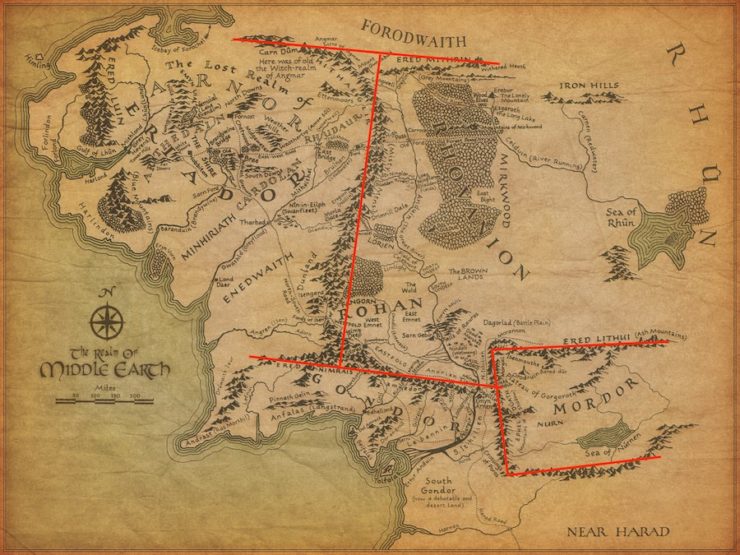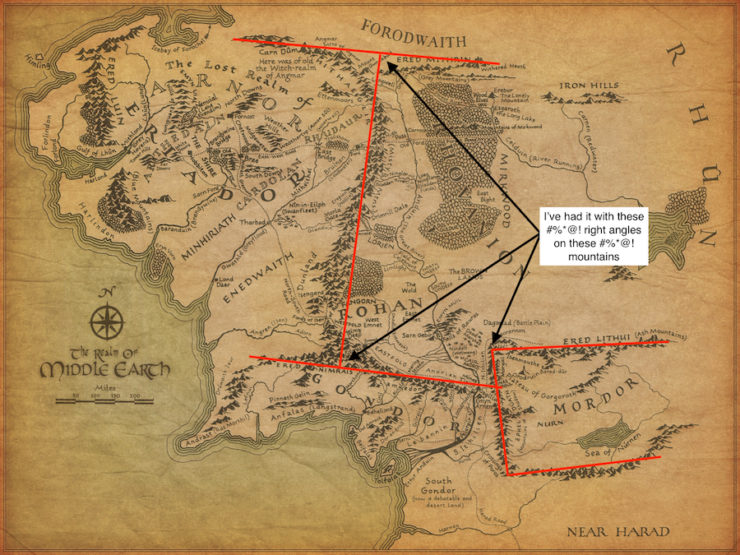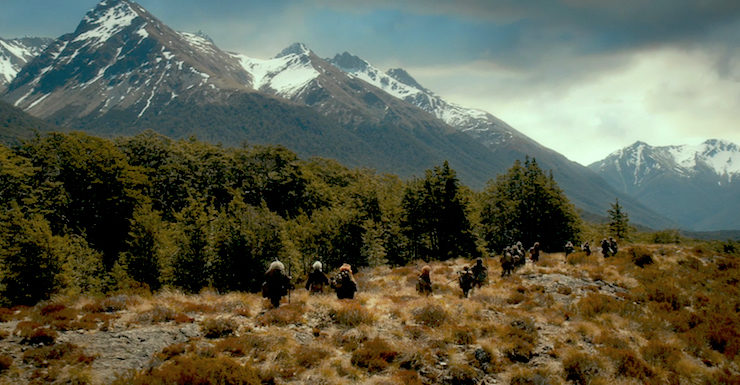We’ve got to talk about Tolkien’s map of Middle-earth. The man might have made up some beautiful languages and written stories that generations of writers have responded to in ways ranging from homage to bad photocopy, but I’m going to guess he was no connoisseur of geography.
Even at an early age, I thought the map of Middle-earth looked a little… odd. With my years of geological education and work experience, now it seems more like a geographical car wreck from which I can’t quite look away. (This is what happens when you spend a lot of student loan dollars on graduate school.)
Middle-earth’s got 99 problems, and mountains are basically 98 of them.
To understand all of the hair-tearing I do every time I look at this map, we need to understand where mountains come from. I talked a little bit about mountain building in my previous post, in the context of active versus passive margins as seen in the case of The Hunger Games’ Panem. The big thing to keep in mind is that mountain ranges are the fingerprints left behind by tectonic activity. Everything on the surface of the Earth ultimately wants to return to base level, also known as sea level. Given a long enough time and no tectonic activity to mess things up, the land surface would all end up being pretty close to sea level. Tectonic activity is what keeps wrinkling up the surface and giving all the water some elevation to run down.
The main creator of mountains are tectonic plate collisions. You either end up with the heavier oceanic plate grinding under the continental crust—which is lighter because it’s got a lot more silicates in it—and wrinkling it up that way, as seen all around the Pacific Rim; or you have two plates of roughly equal density colliding and, since one isn’t going to sink under the other, building up and up like a cartoonish car pileup, which is why the Himalayas keep getting a little bit taller every year.
Extensional tectonics is another way to wrinkle up your crust that isn’t going to create mountains in quite the same way. This happens when the crust is under tensional stress (being pulled apart) rather than the compressive stress (being squished together) you get from tectonic collisions. On a continent, the stretched crust will thin out and fault, which allows blocks to drop down and create oddly parallel low basins with higher crust on either side. (These are also called “horst and graben” landforms.) This is what we see in the Basin and Range Province in the Western US, as well as the Baikal Rift Zone and the rift systems in East Africa. If rifting is continuous enough, you can end up with a new ocean basin, complete with spreading center, cutting your continent in half.
Knowing these basic mechanisms, you can look at a map of the Earth and see how the mountain building comes together. A lot of it’s on those active margins, where oceanic crust is subducting under continental crust. When you get mountains cutting in the middle of continents, it shows where there were continent-continent collusions, with the mountains acting like sutures and tying the land masses together.
Which brings us back to the map of Middle-earth. There’s some weird stuff going on with these mountain ranges. To illustrate, I’ve added some lines to the map so you can more clearly see what I see whenever I look at it.

I’m good with the mountain ranges on the west coast of the map. I can pretend that Eriador is like the California of Middle-earth, and it’s a nice active margin—I will just ignore that my housemate, who unlike me has completed the Silmarillion slog, has disabused me of that notion. And I can buy the placement of the Misty Mountains, again as a continent-continent collision, perhaps, even if there should be a lot more shenanigans going on then, in terms of elevation. But when you throw in the near perpendicular north and south mountain ranges? Why are there corners? Mountains don’t do corners.

And Mordor? Oh, I don’t even want to talk about Mordor.
Tectonic plates don’t tend to collide at neat right angles, let alone in some configuration as to create a nearly perfect box of mountains in the middle of a continent. I’ve heard the reasoning before that suggests Sauron has made those mountains somehow, and I suppose right angles are a metaphor for the evil march of progress, but I don’t recall that being in the books I read. And ultimately, this feels a lot like defending the cake in the song MacArthur Park as a metaphor—okay fine, maybe it’s a metaphor…but it’s a silly metaphor that makes my geologist heart cry tears of hematite.
Mount Doom, I’m more likely to give a pass to, since it’s obviously a place of great magic. But geologically, it posits a mantle plume creating a hot spot under Mordor—since that’s the only way you’re going to get a volcano away from subduction or rifting zones, and I’ve already called shenanigans on Mordor being either of those. And the hallmark of hot spot volcanism is that you get chains of volcanoes, with the youngest being the active volcano and the older ones normally quiescent. This is caused by the tectonic plates moving over the hot spot; examples include the Juan Fernández Ridge, the Tasmantid Seamount Chain, and the Hawaiian Islands (more properly called the Hawaiian-Emperor seamount chain). You’ll notice most hot spots can be found in the oceans, because there’s more ocean on Earth than land, and also the crust is thinner there, so a hot spot causes volcanism much more readily. On continents, you’re more likely to get dike swarms (e.g.: the Mackenzie dike swarm in Nunavet, Canada) where magma filters into cracks and weak spots between formations and remains underground until unroofed by erosion—or chains of massive volcanic calderas like the ones you see ranging from Yellowstone to the Valles Caldera in the US.
Okay, so maybe Mount Doom is from a really young hot spot and there’s been no drift since it started. That’s the best I’ve got for you. It’s better than the nonsensical border mountains.
To be fair to J.R.R. Tolkien, while continental drift was a theory making headway in the world of geology from 1910 onwards, plate tectonics didn’t arrive on the scene until the mid-50s, and then it took a little while to become accepted science. (Though goodness, plate tectonics came down—I have it on good authority from geologists who were alive and in school at the time that it was like the holy light of understanding shining forth. Suddenly, so many things made sense.) Fantasy maps drawn after the 1960s don’t get even that overly generous pass.
But even without understanding the major forces behind mountain building, all you have to do is look at a topographic map of the world around us to get a sense of where mountains might naturally grow. There aren’t right angles in the mountain ranges of Earth. Trust me, I’ve looked. There also aren’t massive rivers that run parallel to those mountain ranges for long distances—remember that one problem I mentioned earlier that wasn’t mountains?—but that’s a discussion for another time.
Top image from The Hobbit: An Unexpected Journey (2012)
Alex Acks is a writer, geologist, Twitter fiend, and dapper AF. Their sweary biker space witch debut novel, Hunger Makes the Wolf, is out now from Angry Robot Books.










